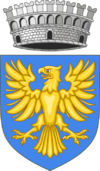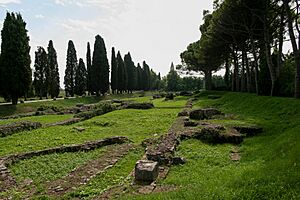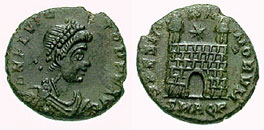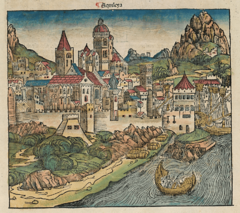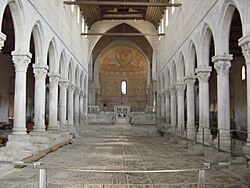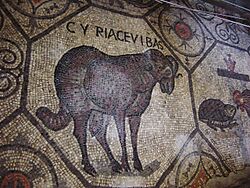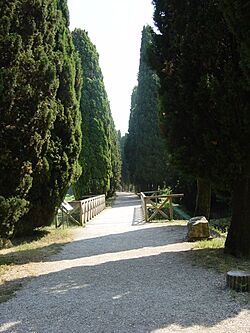Aquileia facts for kids
Quick facts for kids
Aquileia
Olee / Acuilee (Friulian)
|
|||
|---|---|---|---|
| Comune di Aquileia | |||
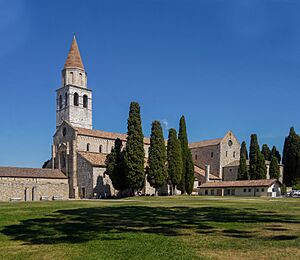
The Basilica of Aquileia.
|
|||
|
|||
| Country | Italy | ||
| Region | Friuli-Venezia Giulia | ||
| Province | Udine (UD) | ||
| Frazioni | Beligna, Belvedere, Viola, Monastero | ||
| Area | |||
| • Total | 37.44 km2 (14.46 sq mi) | ||
| Elevation | 5 m (16 ft) | ||
| Population
(30 April 2017)
|
|||
| • Total | 3,302 | ||
| • Density | 88.194/km2 (228.42/sq mi) | ||
| Demonym(s) | Aquileiesi | ||
| Time zone | UTC+1 (CET) | ||
| • Summer (DST) | UTC+2 (CEST) | ||
| Postal code |
33051
|
||
| Dialing code | 0431 | ||
| Patron saint | Sts. Hermagoras and Fortunatus | ||
| Saint day | July 12 | ||
| UNESCO World Heritage Site | |||
| Official name | Archaeological Area and the Patriarchal Basilica of Aquileia | ||
| Criteria | Cultural: iii, iv, vi | ||
| Inscription | 1998 (22nd Session) | ||
Aquileia is an ancient Roman city in Italy. It's located at the top of the Adriatic Sea, near some lagoons. Even though it's a small town today with about 3,500 people, it was once a huge and important city in ancient times. In the 2nd century AD, it had around 100,000 residents, making it one of the world's largest cities.
Aquileia is now one of the most important archaeological sites in northern Italy. It's famous for its rich history and ancient ruins. In later Roman times, it was the first city in Italy to be attacked and destroyed by Attila the Hun. Today, Aquileia is a municipality (a type of town) in the Province of Udine in the Friuli-Venezia Giulia region.
Contents
History
Ancient Roman Times
How Aquileia Started
The Romans founded Aquileia as a new settlement in 180 or 181 BC. It was built along the Natiso River, about 13 kilometers (8 miles) north of the lagoons. The main reason for building it was to create a strong fortress. This fortress would protect Rome's allies, the Veneti, and stop other warlike groups like the Carni and Histri from invading.
The location was also important for trade. Since the 13th century BC, it had been a key spot for the "Baltic amber" trade route. This meant that valuable amber from the Baltic Sea ended its journey here.
Three Roman leaders, Publius Cornelius Scipio Nasica, Caius Flaminius, and Lucius Manlius Acidinus, led 3,000 families to settle in Aquileia. This means the city likely had about 20,000 people soon after it was founded. Most of these families came from other parts of Italy, like Picenum, Samnium, and Campania.
Growing as a City
Aquileia quickly became connected to other Roman cities by roads. In 148 BC, the Via Postumia linked it to cities across the Padanian plain. Later, the Via Popilia and Via Gemina further improved its connections. These roads helped Aquileia become a major trade center.
In 169 BC, more Roman settlers arrived, strengthening the city's defenses. The discovery of gold fields nearby in 130 BC made Aquileia even more important. It became a busy place for trade, especially in farm products and wine. It also had large brick-making factories.
By 90 BC, Aquileia became a municipium, which meant its citizens had more rights and the city could govern itself more. Even Julius Caesar visited the city several times.
Aquileia in the Roman Empire
Aquileia continued to grow during the Roman Empire. Jewish craftspeople created beautiful glass items, and metal from Noricum was shaped and sold. The ancient trade of amber from the Baltic Sea also continued. Aquileia exported its famous wine and imported olive oil.
The city's port, Aquae Gradatae (modern Grado), was developed to handle sea trade. On land, Aquileia was the starting point for many important roads leading out of Italy to the empire's northeastern parts.
Many Roman emperors visited Aquileia, including Augustus. The Roman poet Martial even wrote about wanting to retire there. People in Aquileia worshipped Roman gods, but they also followed the Celtic sun-god, Belenus. Jewish people practiced their religion, and soldiers brought the worship of Mithras.
In 167 AD, during a war against the Marcomanni, Aquileia faced difficulties. Its walls were not in good shape after a long period of peace. However, in 168 AD, Emperor Marcus Aurelius made Aquileia the main fortress against northern and eastern invaders. This made the city even more important, and its population grew to 100,000.
In 238 AD, Aquileia supported the Roman Senate against Emperor Maximinus Thrax. The city's defenses were quickly repaired, and they were strong enough to hold out for several months. Maximinus was eventually killed during this siege.
Later Roman Times and Beyond
An imperial palace was built in Aquileia, and many emperors stayed there. During the 4th century, Aquileia remained very important. Emperor Constantine the Great visited often. It became a naval base and a center for making coins. The bishop of Aquileia became a very high-ranking church leader, an archbishop.
Aquileia was also involved in the power struggles of the 4th century. In 340 AD, Emperor Constantine II was killed near the city. At the end of the 4th century, a writer named Ausonius listed Aquileia as the ninth greatest city in the world.
However, being so prominent also made it a target. Alaric I and his Visigoth army attacked it in 401 and again in 408. Some residents fled to nearby lagoons during these attacks. In 452 AD, Attila the Hun and his Huns completely destroyed the city. It was so ruined that it was hard to recognize where it had been. Many Roman people fled to the lagoons, where they started new cities like Venice and Grado.
Aquileia was rebuilt, but it was much smaller. It continued to exist until the Lombards invaded in 568 AD and destroyed it again in 590 AD. The church leader (patriarch) fled to Grado. This led to a split in the church, with one patriarch in Grado and another in Aquileia (who later moved to Cormons and then Cividale).
Middle Ages
During the Middle Ages, the Lombard dukes of Friuli ruled Aquileia. In 774, Charlemagne conquered the area. He appointed a new patriarch for Aquileia, Paulinus II of Aquileia. The patriarchate (the area governed by the patriarch) remained one of the largest church regions.
Over time, the patriarch of Aquileia became very powerful. By the 11th century, the Holy Roman Emperor gave the region to the patriarch as his own land. This meant the patriarch had both religious and political power.
In the 14th century, the Patriarchal State of Aquileia reached its largest size, stretching from the Piave river to the Julian Alps. However, in 1420, Venice took control of the area. The patriarch's political power ended in 1445, and the region became part of the Republic of Venice. The church diocese itself was officially closed in 1751, and new church areas were created in Udine and Gorizia.
Main Sights
Aquileia Cathedral
The Aquileia Cathedral is a large church with a flat roof. It was first built in 1031 by Patriarch Poppo on the site of an even older church. Later, it was rebuilt in the Gothic style. Inside, you can see amazing mosaic floors that are very old and beautiful.
Ancient Roman Ruins
Today, Aquileia is smaller than it was in Roman times. Over many centuries, wars, earthquakes, floods, and people taking stones from old buildings have meant that no Roman buildings still stand above ground. However, Aquileia is believed to be the largest Roman city that has not yet been fully dug up by archaeologists. It is a UNESCO World Heritage Site.
Excavations have uncovered parts of the Roman town. You can see a section of an ancient street, parts of the old town walls, and the remains of the river port. Archaeologists have also found where baths, an amphitheater, a circus, a cemetery, the Via Sacra (a sacred road), the forum (the main public square), and a market used to be.
The National Archaeological Museum of Aquileia is a great place to visit. It has over 2,000 ancient inscriptions, statues, and other artifacts. You can also see beautiful mosaics, old glass items made in the area, and a collection of ancient coins.
Other Sights
In the Monastero area of Aquileia, there is a Christian basilica from the 5th century. It later became a Benedictine monastery and now houses the Palaeo-Christian Museum, which shows early Christian artifacts.
Notable people
- Pope Pius I is thought to have been born in Aquileia in the late 1st century.
- Saint Chrysogonus was martyred (killed for his beliefs) here in the early 4th century.
Twin towns – sister cities
Aquileia is twinned with these towns:
See Also
- Schism of the Three Chapters
- Aquileian rite
- Councils of Aquileia
- List of Aquileia Bishops and patriarchs
- Acaste Bresciani
Images for kids



